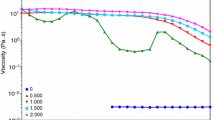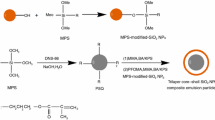Abstract
Hydrophobically modified ethoxylated urethane (HEUR) with different structures was synthesized and confirmed by gel permeation chromatography, Fourier transform infrared spectroscopy and nuclear magnetic resonance (1H NMR). We propose the relationship between the temperature insensitivity model and the thickening mechanism of HEUR/latex/Fe2O3/Zn3(PO4)2/BaSO4 suspensions. Meanwhile, the temperature insensitivity of HEUR/C suspensions is the result of two main associations: intermolecular interactions bridging the hydrophobic tails of HEURs and the hydrophobic groups tightly adsorbing onto the latex particle surfaces. A smaller ratio of viscosity (Rv) at 1 s−1 from the steady state condition indicates the better temperature insensitivity of viscosity. The higher degree of crystallinity and rheological activation energy corresponds to a great extent with better temperature insensitivity due to stronger association. The temperature insensitivity is consistent with the longer hydrophobic chain, which was proven by hysteresis tests and oscillatory shear measurements. The storage stability was enhanced in the lockstep with a hydrophobic length of HEUR, which is consistent with the rougher surfaces of HEUR/C films. As an appealing method, the results are meaningful and instructive for coating storage and application.
Graphical abstract
An intermolecular network model of HEUR/C is presented, which suggests intermolecular associations in the bridging of hydrophobic tails and the hydrophobic groups adsorbing onto the latex particle surfaces. A temperature insensitivity mechanism model combined with rheology results and AFM is also proposed to clarify the relationship between temperature insensitivity and storage stability and the hydrophobic tail length.











Similar content being viewed by others
References
Uneyama, T, Suzuki, S, Watanabe, H, “Concentration Dependence of Rheological Properties of Telechelic Associative Polymer Solutions.” Phys. Rev. E, 86 (3–1) 031802 (2012)
Tam, KC, Jenkins, RD, Winnik, MA, et al. “A Structural Model of Hydrophobically Modified Urethane−Ethoxylate (HEUR) Associative Polymers in Shear Flows.” Macromolecules, 31 (13) 4149–4159 (1998)
Xie, A, Chen, H, Xu, C, et al. “Synthesis and Characterization of Waterborne Polyurethane Thickeners Based on Hyperbranched Polyester.” J. Coat. Technol. Res., 12 (2) 325–332 (2014)
Sarrafi, M, Kaffashi, B, Barmar, M, “Study of the Simultaneous Effects of MMT Nanoclay and Hydrophobically Modified Ethoxylated Urethane (HEUR) on Viscoelastic and Steady Shear Properties of Water-Based Acrylic Resins.” J. Coat. Technol. Res., 10 (5) 727–731 (2013)
Yin, W, Zeng, X, Li, H, et al. “Steady Rheological Behaviors of UV-Curable Waterborne Hyperbranched Polyurethane Acrylate Dispersions.” J. Coat. Technol. Res., 10 (1) 57–64 (2012)
Suzuki, S, Uneyama, T, Inoue, T, et al. “Nonlinear Rheology of Telechelic Associative Polymer Networks: Shear Thickening and Thinning Behavior of Hydrophobically Modified Ethoxylated Urethane (HEUR) in Aqueous Solution.” Macromolecules, 45 (2) 888–898 (2012)
Birjandi Nejad, H, Paczkowski, MA, Malajati, Y, Melkowits, RB, “Polyurethane Rheology Modifiers for Organic Compositions.” J. Appl. Polym. Sci., 135 46372 (2018)
Bhavsar, RA, Nehete, KM, “Rheological Approach to Select most Suitable Associative Thickener for Water-Based Polymer Dispersions and Paints.” J. Coat. Technol. Res., 16 1089–1098 (2019)
Xu, C, Chen, H, Xie, A, Chen, H, Zhou, Y, Li, Y, Yang, M, “Study on Associating Thickening Mechanism and Structure–Efficiency Relationship of Hyperbranched Waterborne Polyurethane.” Prog. Org. Coat., 92 73–79 (2016)
Chatterjee, T, Nakatani, AI, Van Dyk, AK, “Shear-Dependent Interactions in Hydrophobically Modified Ethylene Oxide Urethane (HEUR) Based Rheology Modifier-Latex Suspensions: Part 1. Molecular Microstructure.” Macromolecules, 47 1155–1174 (2014)
Yang, P, Bai, L, Wang, W, Rabasco, J, “Analysis of Hydrophobically Modified Ethylene Oxide Urethane Rheology Modifiers by Comprehensive Two Dimensional Liquid Chromatography.” J. Chromatogr. A, 1560 55–62 (2018)
Ginzburg, VV, Chatterjee, T, Nakatani, AI, Van Dyk, AK, “Oscillatory and Steady Shear Rheology of Model Hydrophobically Modified Ethoxylated Urethane-Thickened Waterborne Paints.” Langmuir, 3 10993–11002 (2018)
Horigome, M, Yada, M, Isoda, T, “Rheological Behavior of PMMA Powder/ Associating Polymer Suspensions.” Nihon Reoroji Gakk., 26 (3) 157–162 (1998)
Liao, D, Dai, S, Tam, KC, “Influence of Anionic Surfactant on the Rheological properties of Hydrophobically Modified Polyethylene-Oxide/Cyclodextrin Inclusion Complexes.” J. Rheol., 53 (2) 293–308 (2009)
Du, Z, Wang, F, Chang, X, Peng, J, Ren, B, “Influence of Substituted Structure of Percec-Type Mini-Dendritic End Groups on Aggregation and Rheology of Hydrophobically Modified Ethoxylated Urethanes (HEURs) in Aqueous Solution.” Polymer, 135 131–141 (2018)
Wang, F, Peng, J, Dong, R, Chang, X, Ren, B, Tong, Z, “Highly Efficient Hydrophobically Modified Ethoxylated Urethanes (HEURs) End-Functionalized by Two-Tail Dendritic Hydrophobes: Synthesis, Solution Rheological Behavior and Thickening in Latex.” Colloid Surf. A., 502 114–120 (2016)
Peng, J, Dong, R, Ren, B, Chang, X, Tong, Z, “Novel Hydrophobically Modified Ethoxylated Urethanes End-Capped by Percec-Type Alkyl Substituted Benzyl Alcohol Dendrons: Synthesis, Characterization, and Rheological Behavior.” Macromolecules, 47 5971–5981 (2014)
Peng, J, Guan, T, Ren, B, “Study on Thickening Mechanism and Thickening Efficiency of Polyurethane Associated Thickener.” Guangdong Chemical Industry, 48 135-136+138 (2021)
Rubio-Hernández, FJ, López-Galbeño, A, Muñoz-Cabezas, AM, Ruiz-Martín, D, Gómez-Merino, AI, Páez-Flor, NM, Delgado-García, R, “Rheological Study of the Anatase/Latex Polystyrene System.” Rev. Mex. de Ing. Quim., 15 (2) 655–665 (2016)
He, C, Zeng, J, Luo, Y, “Method for Preparing Waterborne Styrene-Acrylate Emulsion Used in Common Waterborne Metal Primer.” CN Patent 107698706 (2017)
Xu, J, Koelling, KW, “Temperature Dependence of Rheological Behavior of a Metallic Automotive Waterborne Basecoat.” Prog. Org. Coat., 53 169–176 (2005)
Matia-Merino, L, Goh, K, Singh, KTH, “A Natural Shear-Thickening Water-Soluble Polymer From the Fronds of The Black Tree Fern, Cyathea medullaris: Influence of Salt, pH and Temperature.” Carbohydr. Polym., 87 131–138 (2012)
Annable, T, Buscall, R, Ettelaie, R, Whittlestone, D, “The Rheology of Solutions of Associating Polymers: Comparison of Experimental Behavior with Transient Network Theory.” J. Rheol., 37 (4) 695–726 (1993)
Lu, M, Song, C, Wan, B, “Thixotropic Behavior of Hydrophobically Modified Ethoxylated Urethane-thickened Waterborne Latex.” Chem. J. Chinese Universities, 41 1108–1119 (2020)
Yan, G, “Rheopectical Properties of Nano-scale Calcium Carbonate Filled DOP Suspension.” China Powder Sci. Technol., 4 4 (2016)
Barnes, HA, “Thixotropy: A Review.” J. Non-Newtonian Fluid Mech., 70 (1) 1–33 (1997)
Osterhold, M, “Rheological Methods for Characterising Modern Paint Systems.” Prog. Org. Coat., 40 131–137 (2000)
Ferry, JD, Viscoelastic Properties of Polymers. Wiley, New York (1980)
Maghazechi, A, Nafchi, AM, Tan, TC, Seow, EK, Easa, AM, “Rheological Characterization of Coconut Cream Emulsion Using Steady-State Shear and Time-Dependent Modeling.” J. Food Eng., 306 110642 (2021)
Acknowledgments
The financial support from the NSFC (51203050).
Author information
Authors and Affiliations
Corresponding author
Additional information
Publisher's Note
Springer Nature remains neutral with regard to jurisdictional claims in published maps and institutional affiliations.
Rights and permissions
Springer Nature or its licensor holds exclusive rights to this article under a publishing agreement with the author(s) or other rightsholder(s); author self-archiving of the accepted manuscript version of this article is solely governed by the terms of such publishing agreement and applicable law.
About this article
Cite this article
Lin, Y., Song, C., Xiao, X. et al. Influence of the association of hydrophobic end groups on the temperature insensitivity of HEUR-thickened latex/Fe2O3/Zn3(PO4)2/BaSO4 suspensions. J Coat Technol Res 20, 587–601 (2023). https://doi.org/10.1007/s11998-022-00692-0
Received:
Revised:
Accepted:
Published:
Issue Date:
DOI: https://doi.org/10.1007/s11998-022-00692-0




